[English] 日本語
 Yorodumi
Yorodumi- PDB-5tx4: Derivative of mouse TGF-beta2, with a deletion of residues 52-71 ... -
+ Open data
Open data
- Basic information
Basic information
| Entry | Database: PDB / ID: 5tx4 | ||||||||||||
|---|---|---|---|---|---|---|---|---|---|---|---|---|---|
| Title | Derivative of mouse TGF-beta2, with a deletion of residues 52-71 and K25R, R26K, L51R, A74K, C77S, L89V, I92V, K94R T95K, I98V single amino acid substitutions, bound to human TGF-beta type II receptor ectodomain residues 15-130 | ||||||||||||
 Components Components |
| ||||||||||||
 Keywords Keywords | TRANSFERASE/CYTOKINE / TGF-beta / TGF-beta type II receptor / TRANSFERASE-CYTOKINE complex | ||||||||||||
| Function / homology |  Function and homology information Function and homology informationregulation of timing of catagen / regulation of apoptotic process involved in outflow tract morphogenesis / negative regulation of epithelial to mesenchymal transition involved in endocardial cushion formation / substantia propria of cornea development / ascending aorta morphogenesis / positive regulation of activation-induced cell death of T cells / cardioblast differentiation / positive regulation of tolerance induction to self antigen / positive regulation of B cell tolerance induction / uterine wall breakdown ...regulation of timing of catagen / regulation of apoptotic process involved in outflow tract morphogenesis / negative regulation of epithelial to mesenchymal transition involved in endocardial cushion formation / substantia propria of cornea development / ascending aorta morphogenesis / positive regulation of activation-induced cell death of T cells / cardioblast differentiation / positive regulation of tolerance induction to self antigen / positive regulation of B cell tolerance induction / uterine wall breakdown / inferior endocardial cushion morphogenesis / transforming growth factor beta receptor activity, type II / bronchus morphogenesis / positive regulation of timing of catagen / mammary gland morphogenesis / lens fiber cell apoptotic process / growth plate cartilage chondrocyte growth / positive regulation of cardioblast differentiation / tricuspid valve morphogenesis / TGFBR2 MSI Frameshift Mutants in Cancer / cardiac right ventricle morphogenesis / miRNA transport / regulation of transforming growth factor beta2 production / transforming growth factor beta ligand-receptor complex / atrial septum morphogenesis / pharyngeal arch artery morphogenesis / type III transforming growth factor beta receptor binding / aorta morphogenesis / positive regulation of epithelial to mesenchymal transition involved in endocardial cushion formation / positive regulation of heart contraction / Langerhans cell differentiation / TGFBR2 Kinase Domain Mutants in Cancer / transforming growth factor beta receptor activity / activation-induced cell death of T cells / glial cell migration / cardiac left ventricle morphogenesis / positive regulation of extracellular matrix disassembly / secondary palate development / negative regulation of macrophage cytokine production / SMAD2/3 Phosphorylation Motif Mutants in Cancer / TGFBR1 KD Mutants in Cancer / somatic stem cell division / positive regulation of integrin biosynthetic process / endocardial cushion fusion / atrial septum primum morphogenesis / heart valve morphogenesis / membranous septum morphogenesis / positive regulation of T cell tolerance induction / positive regulation of NK T cell differentiation / negative regulation of cartilage development / cardiac epithelial to mesenchymal transition / TGFBR3 regulates TGF-beta signaling / signaling / positive regulation of stress-activated MAPK cascade / neuron fate commitment / pericyte cell differentiation / activin receptor complex / activin receptor activity, type I / lung lobe morphogenesis / transforming growth factor beta receptor binding / eye development / embryonic digestive tract development / neural retina development / type II transforming growth factor beta receptor binding / receptor protein serine/threonine kinase / regulation of stem cell proliferation / transmembrane receptor protein serine/threonine kinase activity / activin binding / cranial skeletal system development / TGFBR1 LBD Mutants in Cancer / SMAD protein signal transduction / pulmonary valve morphogenesis / type I transforming growth factor beta receptor binding / myeloid dendritic cell differentiation / embryonic cranial skeleton morphogenesis / glycosaminoglycan binding / activin receptor signaling pathway / ventricular trabecula myocardium morphogenesis / negative regulation of Ras protein signal transduction / positive regulation of CD4-positive, alpha-beta T cell proliferation / embryo development ending in birth or egg hatching / regulation of stem cell differentiation / response to cholesterol / outflow tract septum morphogenesis / positive regulation of extrinsic apoptotic signaling pathway in absence of ligand / cell-cell junction organization / transforming growth factor beta binding / collagen fibril organization / kinase activator activity / embryonic limb morphogenesis / positive regulation of cell adhesion mediated by integrin / lens development in camera-type eye / aortic valve morphogenesis / atrioventricular valve morphogenesis / face morphogenesis / odontogenesis / positive regulation of mesenchymal cell proliferation / artery morphogenesis / embryonic hemopoiesis / Molecules associated with elastic fibres Similarity search - Function | ||||||||||||
| Biological species |  Homo sapiens (human) Homo sapiens (human) | ||||||||||||
| Method |  X-RAY DIFFRACTION / X-RAY DIFFRACTION /  SYNCHROTRON / SYNCHROTRON /  MOLECULAR REPLACEMENT / Resolution: 1.876 Å MOLECULAR REPLACEMENT / Resolution: 1.876 Å | ||||||||||||
 Authors Authors | Hinck, A.P. / Kim, S. | ||||||||||||
| Funding support |  United States, 3items United States, 3items
| ||||||||||||
 Citation Citation |  Journal: J. Biol. Chem. / Year: 2017 Journal: J. Biol. Chem. / Year: 2017Title: An engineered transforming growth factor beta (TGF-beta ) monomer that functions as a dominant negative to block TGF-beta signaling. Authors: Kim, S.K. / Barron, L. / Hinck, C.S. / Petrunak, E.M. / Cano, K.E. / Thangirala, A. / Iskra, B. / Brothers, M. / Vonberg, M. / Leal, B. / Richter, B. / Kodali, R. / Taylor, A.B. / Du, S. / ...Authors: Kim, S.K. / Barron, L. / Hinck, C.S. / Petrunak, E.M. / Cano, K.E. / Thangirala, A. / Iskra, B. / Brothers, M. / Vonberg, M. / Leal, B. / Richter, B. / Kodali, R. / Taylor, A.B. / Du, S. / Barnes, C.O. / Sulea, T. / Calero, G. / Hart, P.J. / Hart, M.J. / Demeler, B. / Hinck, A.P. | ||||||||||||
| History |
|
- Structure visualization
Structure visualization
| Structure viewer | Molecule:  Molmil Molmil Jmol/JSmol Jmol/JSmol |
|---|
- Downloads & links
Downloads & links
- Download
Download
| PDBx/mmCIF format |  5tx4.cif.gz 5tx4.cif.gz | 88.2 KB | Display |  PDBx/mmCIF format PDBx/mmCIF format |
|---|---|---|---|---|
| PDB format |  pdb5tx4.ent.gz pdb5tx4.ent.gz | 66.7 KB | Display |  PDB format PDB format |
| PDBx/mmJSON format |  5tx4.json.gz 5tx4.json.gz | Tree view |  PDBx/mmJSON format PDBx/mmJSON format | |
| Others |  Other downloads Other downloads |
-Validation report
| Summary document |  5tx4_validation.pdf.gz 5tx4_validation.pdf.gz | 427.1 KB | Display |  wwPDB validaton report wwPDB validaton report |
|---|---|---|---|---|
| Full document |  5tx4_full_validation.pdf.gz 5tx4_full_validation.pdf.gz | 428 KB | Display | |
| Data in XML |  5tx4_validation.xml.gz 5tx4_validation.xml.gz | 9.9 KB | Display | |
| Data in CIF |  5tx4_validation.cif.gz 5tx4_validation.cif.gz | 13.1 KB | Display | |
| Arichive directory |  https://data.pdbj.org/pub/pdb/validation_reports/tx/5tx4 https://data.pdbj.org/pub/pdb/validation_reports/tx/5tx4 ftp://data.pdbj.org/pub/pdb/validation_reports/tx/5tx4 ftp://data.pdbj.org/pub/pdb/validation_reports/tx/5tx4 | HTTPS FTP |
-Related structure data
| Related structure data |  5tx2SC  5tx6C  1m9zS S: Starting model for refinement C: citing same article ( |
|---|---|
| Similar structure data |
- Links
Links
- Assembly
Assembly
| Deposited unit | 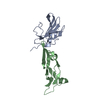
| ||||||||
|---|---|---|---|---|---|---|---|---|---|
| 1 | 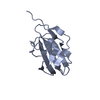
| ||||||||
| 2 | 
| ||||||||
| Unit cell |
|
- Components
Components
| #1: Protein | Mass: 13225.042 Da / Num. of mol.: 1 / Fragment: UNP residues 38-153 Source method: isolated from a genetically manipulated source Source: (gene. exp.)  Homo sapiens (human) / Gene: TGFBR2 / Production host: Homo sapiens (human) / Gene: TGFBR2 / Production host:  References: UniProt: P37173, receptor protein serine/threonine kinase |
|---|---|
| #2: Protein | Mass: 10501.184 Da / Num. of mol.: 1 / Fragment: UNP residues 303-414 Mutation: deletion of residues 52-71 and K25R, R26K, L51R, A74K, C77S, L89V, I92V, K94R T95K, I98V Source method: isolated from a genetically manipulated source Source: (gene. exp.)  Homo sapiens (human) / Gene: TGFB2 / Production host: Homo sapiens (human) / Gene: TGFB2 / Production host:  |
| #3: Water | ChemComp-HOH / |
| Has protein modification | Y |
-Experimental details
-Experiment
| Experiment | Method:  X-RAY DIFFRACTION / Number of used crystals: 1 X-RAY DIFFRACTION / Number of used crystals: 1 |
|---|
- Sample preparation
Sample preparation
| Crystal | Density Matthews: 2.24 Å3/Da / Density % sol: 45.18 % |
|---|---|
| Crystal grow | Temperature: 298 K / Method: vapor diffusion, hanging drop / pH: 7.5 Details: 0.1 M Hepes, pH 7.5, 60 % v/v (+/-)-2-Methyl-2,4-pentanediol |
-Data collection
| Diffraction | Mean temperature: 100 K |
|---|---|
| Diffraction source | Source:  SYNCHROTRON / Site: SYNCHROTRON / Site:  APS APS  / Beamline: 22-ID / Wavelength: 0.9795 Å / Beamline: 22-ID / Wavelength: 0.9795 Å |
| Detector | Type: RAYONIX MX300-HS / Detector: CCD / Date: Apr 2, 2016 |
| Radiation | Protocol: SINGLE WAVELENGTH / Monochromatic (M) / Laue (L): M / Scattering type: x-ray |
| Radiation wavelength | Wavelength: 0.9795 Å / Relative weight: 1 |
| Reflection | Resolution: 1.876→35.39 Å / Num. obs: 17715 / % possible obs: 99.6 % / Redundancy: 6.8 % / Rsym value: 0.143 / Net I/σ(I): 15.17 |
- Processing
Processing
| Software |
| |||||||||||||||||||||||||||||||||||||||||||||||||
|---|---|---|---|---|---|---|---|---|---|---|---|---|---|---|---|---|---|---|---|---|---|---|---|---|---|---|---|---|---|---|---|---|---|---|---|---|---|---|---|---|---|---|---|---|---|---|---|---|---|---|
| Refinement | Method to determine structure:  MOLECULAR REPLACEMENT MOLECULAR REPLACEMENTStarting model: 1M9Z,5TX2 Resolution: 1.876→35.386 Å / SU ML: 0.18 / Cross valid method: FREE R-VALUE / σ(F): 1.35 / Phase error: 25.97 / Stereochemistry target values: ML
| |||||||||||||||||||||||||||||||||||||||||||||||||
| Solvent computation | Shrinkage radii: 0.9 Å / VDW probe radii: 1.11 Å / Solvent model: FLAT BULK SOLVENT MODEL | |||||||||||||||||||||||||||||||||||||||||||||||||
| Refinement step | Cycle: LAST / Resolution: 1.876→35.386 Å
| |||||||||||||||||||||||||||||||||||||||||||||||||
| Refine LS restraints |
| |||||||||||||||||||||||||||||||||||||||||||||||||
| LS refinement shell |
|
 Movie
Movie Controller
Controller



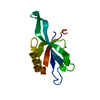
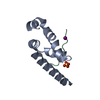
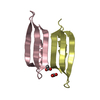
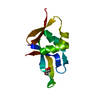
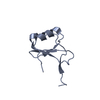
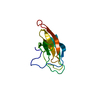
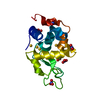
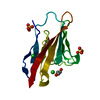
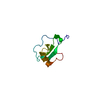
 PDBj
PDBj









